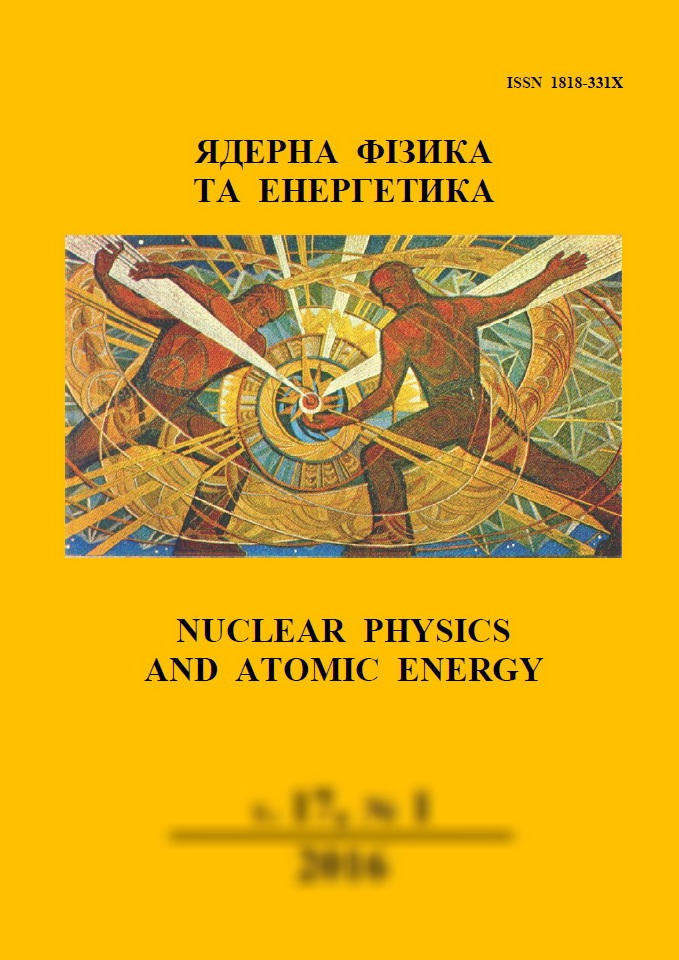 |
Ядерна фізика та енергетика
Nuclear Physics and Atomic Energy
ISSN:
1818-331X (Print), 2074-0565 (Online)
Publisher:
Institute for Nuclear Research of the National Academy of Sciences of Ukraine
Languages:
Ukrainian, English, Russian
Periodicity:
4 times per year
Open access peer reviewed journal
|
Nucl. Phys. At. Energy 2017, volume 18, issue 1, pages 98-105.
Section: Engineering and Methods of Experiment.
Received: 18.04.2017; Accepted: 15.06.2017; Published online: 7.08.2017.
 Full Text (ru)
Full Text (ru)
https://doi.org/10.15407/jnpae2017.01.098
Simulation of ions interaction with biological environment using Geant4
S. O. Liulchenko*, M. О. Zhovner, O. M. Kalinkevich
Institute of Applied Physics, National Academy of Sciences of Ukraine, Sumy, Ukraine
*Corresponding author. E-mail address:
liulchenko.s.o@gmail.com.
Abstract:
Computer model that makes it possible to study the interaction of ion beam with biological objects has been created.
Contribution of secondary particles to the formation of the total radiation dose was investigated. The model contains all
the necessary elements of formation of ion beam and we can interactively change the parameters of the model. For
processing of simulation results additional program codes were created. Studies were carried out on the object which
size and physicochemical properties are similar to biological cell in the human body.
Keywords:
Geant4, dose distribution, biological cell, free path of particle, Bragg peak, Monte Carlo method, secondary processes.
References:
1. V. McLane et al., ENDF-102 Data formats and procedures for evaluated nuclear data file ENDF-6, Technical report BNL-NCS44945/04-Rev. Brookhaven National Laboratory, National Nuclear Data Centre, Upton, NY, USA (1997).
http://www.oecd-nea.org/dbdata/data/manual-endf/endf102_2001.pdf
2. http://www.geant4.org/.
3. S. Agostinelli et al., GEANT4 - a simulation toolkit, Nucl. Instrum. Methods Phys. Res. A 506 (2003) 250 - 303.
https://doi.org/10.1016/S0168-9002(03)01368-8
4. M.J. Berger, Penetration of proton beams trough water I. Depth-dose distribution, spectra and LET distribution, Report NISTIR 5226, National Institute of Standards and Technology, Physics Laboratory, Gaisersburg (1993).
https://ia800606.us.archive.org/22/items/penetrationofpro5226berg/penetrationofpro5226berg.pdf
5. T. Bortfeld, An analytical approximation of the Bragg curve for therapeutic proton beams, Med. Phys. 24, No. 12 (1997) 2024 - 2033.
https://doi.org/10.1118/1.598116
6. J.F. Briesmeister, MCNP - a general Monte Carlo N-particle transport code, Report No. La-12625-M. Los Alamos National Laboratory (1997).
http://permalink.lanl.gov/object/tr?what=info:lanl-repo/lareport/LA-13709-M
7. R.D. Evans, The Atomic Nucleus, Malabar, FL: Robert E. Krieger (1982).
Google Books
8. M. Fippel, M. Soukup, A Monte Carlo calculation algorithm for protоn therapy, Med. Phys. 31, No. 8 (2004) 2263 - 2273.
9. GEANT4 collaboration, Physics Reference Manual (2003).
http://geant4.web.cern.ch/geant4/UserDocumentation/UsersGuides/PhysicsReferenceManual/fo/PhysicsReferenceManual.pdf
10. ICRU Report 49: Stopping powers and ranges for protons and alpha particles, Bethesda, MD (1993).
11. H. Paganetti, Nuclear interactions in proton therapy: dose and relative biological effect distributions originating from primary and secondary particles, Phys. Med. Biol. 47 (2002) 747 - 764.
https://doi.org/10.1088/0031-9155/47/5/305
12. http://gsi.de/.
13. I. Kawrakow, Accurate condensed history Monte Carlo simulation of electron transport, I. EGSnrc, the new EGS4 version, Med. Phys. 7 (2000) 485 - 498.
https://doi.org/10.1118/1.598917
14. M. Lee, A.E. Nahum, S. Webb, An empirical method to build up a model of proton dose distribution for a radiotherapy treatment planning package, Phys. Med. Biol. 38 (1993) 989 - 998.
https://doi.org/10.1088/0031-9155/38/7/009
15. H. Paganetti, H. Jiang, K. Parodi et al., Clinical implementation of full Monte Carlo dose calculation in proton beam therapy, Phys. Med. Biol. 53 (2008) 4825 - 4853.
https://doi.org/10.1088/0031-9155/53/17/023
